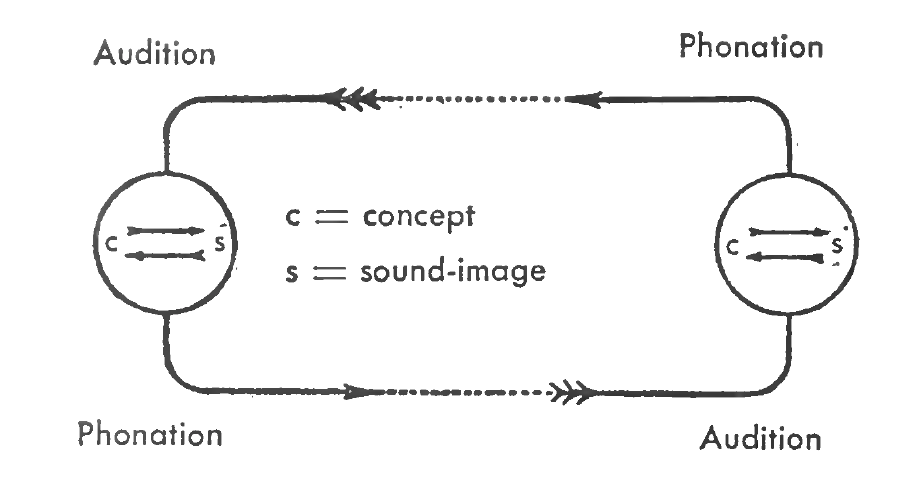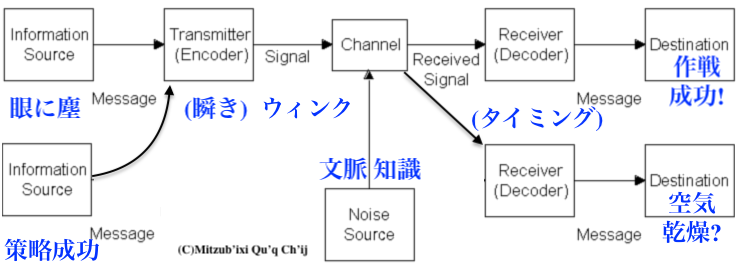Theory of Communication

コミュニケーション理論
Theory of Communication

解説:池田光穂
1.1 コミュニケーション (communication)の語源は、ラテン語のコミュニス(communis)すなわち共通したもの、 あるいは共有物(common コモン)と言われている。これは、コミュニケーションの本質を理解する上で重要なことである。
1.2 「コミュニ ケーションは、したがって、「時間的位相における推移のなかで、情報やデータが『共通のものとなる』という現象一般」のことと定義することができる」
1.3 マルクス主義は、生産手段の〈共有〉を目 標とした社会運動論であり、それが結果的に私的所有の廃絶を生じると想定されていた(→マルクスの《交 通=インコース=性交の意味もある:Verkehr, intercourse》の概念「ドイツ・イデオロギー」 参照)。マルクス(1845)はいう、生業手段の増大(=生産)は、再生 産つまり人口の増大を産む。人口の増大は人間のあいだの《交通》——交換、交易、関係のネットワーク、コミュニケーション、戦争や交渉そして性交——を前 提とする。この形態の《交通》は、再度また人間たちの生産よって決まる(=規定される)のだ、と。ここでも人類の共 通の理想としての共通・共感・共同という一体性が強調されている(→マルクス主義の「進化論的メタファー」の起源;「文化進化論」)。
1.3.1
|
From "First Premises of Materialist Method"- Karl
Marx. The German Ideology.
1845, Part I: Feuerbach. Opposition of the Materialist and Idealist
Outlook, A. Idealism and Materialism. "The way in which men produce their means of subsistence depends first of all on the nature of the actual means of subsistence they find in existence and have to reproduce. This mode of production must not be considered simply as being the production of the physical existence of the individuals. Rather it is a definite form of activity of these individuals, a definite form of expressing their life, a definite mode of life on their part. As individuals express their life, so they are. What they are, therefore, coincides with their production, both with what they produce and with how they produce. The nature of individuals thus depends on the material conditions determining their production." "This production only makes its appearance with the increase of population. In its turn this presupposes the intercourse [Verkehr] of individuals with one another. The form of this intercourse is again determined by production." |
唯物論的方法の第一前提」-カール・マルクスより。ドイツ・イデオロ
ギー』。1845年、第一部:フォイエルバッハ。唯物論的展望と観念論的展望の対立、A.観念論と唯物論。 "人間がその生存手段を生産する方法は、まず第一に、彼らが現存しているのを見つけ、再生産しなければならない実際の生存手段の性質に依存する。この生産 様式は、単に個人の物理的存在の生産であるとみなしてはならない。むしろ、それは、これらの個人の活動の明確な形態であり、彼らの生活を表現する明確な形 態であり、彼らの側の生活の明確な態様である。個人が自分の人生を表現するように、彼らもまたそうである。したがって、彼らが何であるかは、彼らの生産と 一致し、彼らが何を生産するか、どのように生産するかの両方と一致する。個人の性質は、このように、その生産を決定する物質的条件に依存する。" "この生産は人口の増加によってのみ出現する。そして、このことは、個人が互いに交わること[Verkehr]を前提とする。この交通(インターコース) の形態は、再び生産 によって決定される。 |
| Forms of Intercourse Communism differs from all previous movements in that it overturns the basis of all earlier relations of production and intercourse, and for the first time consciously treats all natural premises as the creatures of hitherto existing men, strips them of their natural character and subjugates them to the power of the united individuals. Its organisation is, therefore, essentially economic, the material production of the conditions of this unity; it turns existing conditions into conditions of unity. The reality, which communism is creating, is precisely the true basis for rendering it impossible that anything should exist independently of individuals, insofar as reality is only a product of the preceding intercourse of individuals themselves. Thus the communists in practice treat the conditions created up to now by production and intercourse as inorganic conditions, without, however, imagining that it was the plan or the destiny of previous generations to give them material, and without believing that these conditions were inorganic for the individuals creating them. |
交通の形態 共産主義は、それまでのすべての生産と交通の関係の基礎を覆し、初めて意識的に、すべての自然的前提を、それまで存在していた人間の被造物として扱い、そ の自然的性格を剥ぎ取り、団結した個人の力に服従させるという点で、それまでのすべての運動とは異なっている。したがって、その組織は本質的に経済的であ り、この統一の条件の物質的生産である。共産主義が創造している現実は、まさに、現実が個人自身の先行する交通の産物でしかない限り、個人から独立して何 ものも存在することを不可能にする真の基礎である。従って、共産主義者は、実際には、生産と交通によって現在までに創造された諸条件を無機的条件として扱 うが、しかし、諸条件に物質を与えることが前世代の計画や運命であったとは考えず、これらの諸条件が、それを創造した個人にとって無機的であったとは考え ない。(→「プロレタリアートと共産主義」) |

1.4 コミュニケーションの日本語への翻訳は多 様で辞書をみても、伝達、報道、文通、伝染(cf. communicable disease)、連絡、情報、通信、交通(コミューター)などがあり、何かが伝えられていることを指し示している。しかし、これは伝えられることを通し て、「何かが〈共有〉される」というある事態の結果、ないしはその進行のプロセスのことを意味していると理解したほうがよい。コミュニケーションについて は英語も日本語も、そのような意味の束が主たるものである。[→コミュニケーションスタ ディーズ総論]
1.5 したがってコミュニケーションの理想的な 翻訳は「伝達共有過程」ないしは「伝達の共有」というのが、もっとも語義に叶ったものになる。ここから 展開すると、コミュニケーションはメッセージの相互のやりとり、なしはそのようなやりとりの結果〈ある事象が共有されている状態〉ということになる。
2.1 ウィナー(1961)はメッセージを次のようにそっけなく定義している。つまりメッセージとは 「時間内に分布した測定可能な事象の離散的あるいは連続的な系列のこと」であり「電気的・機械的な方法、あるいは神経系などによって伝送されるもの一切を 含んでいる」と[ウィーナー1962:11]。
2.2 このような〈情報の共有性〉の確保につい て、もっとも簡潔で合理的なモデルを与えたのが、クロード・シャノンとワレン・ウィーバー(1949) であった。
2.3 情報が正しく伝わったり、伝わらなかった (言い換えると、情報が共有されたり、共有されなかったり)するには、情報の発信者と受け手が、別々の 存在であるということが、このモデルの前提になる。それらの間で情報がやりとりされ、最終的に〈共有〉されるわけである。シャノンは情報を数学的にとら え、電気通信的なモデルで表現した。それによると情報源は確率過程として理解され、エントロピー関数により情報量を定義した。
2.4 シャノンとウィーバーの理論の要衝は情報 をいかに迅速かつ正確に伝えることを実現する数学モデルにあった。しかし、人間を含む生物一般や、生物 の体内のシステムにおいても、このような機能プロセスはよく観察されるために、コミュニケーション一般のもっともシンプルで合理的なものとして利用するこ とができる。
2.5 それは情報源(下図で「情報発信者」と表 記)は、伝えたいメッセージを選択し、それを信号に変え、コミュニケーションチャンネル(コミュニケー ション媒体で、音波、電線、電波、インターネットのケーブルなど)を通して、受信体(「受信者」と表記)に送られる。この伝達過程で、情報はさまざまな妨 害をうけ、正確に伝えられないことがある。それをこのモデルはノイズと定義する。受信者は受け取った信号を再びメッセージに解読して、情報発信者の発した メッセージを解読している。情報発信者のメッセージと受信者による解読内容が合致した(共有された)時、コミュニケーションが成立したというのである。
Shannon and Weaver, 1949, p.7(最初のものがオリジナル、次のものが池田が加工したもの)
2.6 シャノンとウィーバーは1949年に『サイエンティフィック・アメリカン』に寄稿した 「分析的コ ミュニケーション・スタディーズ」を冠した論文において、コミュニケーションについて次のように書いている。
【原文】
"The word communication will be used here in a very broad sense to include all of the procedures by which one mind may affect another. This, of course, involves mot only written and oral speech, but also music, the pictorial arts, the theatre, the ballet, and in fact all human behavior. In some connections it may be desirable to use a still broader definition of communication, namely, one which would include the procedures by means of which one mechanism (say automatic equipment to track an airplane and to compute its probable future positions) affects another mechanism (say a guided missile chasing this airplane),"(Shannon and Weaver 1949:3).
【拙訳】
コミュニケーションという言葉は、ある精神(マインド)が別の精神に影響を及ぼすようなもの によって引き起こされる諸手順のすべてを含む、はなはだ広い意味において、ここで使われることだろう。もちろん、これ(=コミュニケーション)には、書か れ話された言葉(スピーチ)のみならず、音楽、絵画芸術、演劇、バレー、それどころか、すべての人間行動までも包摂している。ついでながら言うと、コミュ ニケーションをさらに広い定義でとらえることは妥当なものとなるだろう:つまりそれには、あるメカニズムが別のメカニズムに影響を与えることによる手順を 含めてもよい(例えば、航空機を追跡し想定される将来の位置を計算する自動装置は、その航空機を追尾する誘導ミサイルに影響を及ぼすように) (Shannon and Weaver 1949:3)。
2.7 シャノンとウィーバーによる、この『サイ エンティフィック・アメリカン』論文が重要な点は、彼らのコミュニケーションの定義について「情報論的 で狭量である」という従来の見方は純然たる彼らに対する私たちの誤解に由来することを示す。より積極的に言えば我々は、人間のコミュニケーションの特権性 をないがしろにした責任を、無実のシャノンらに投影する誤謬と偏見をもってきたことなのであり、そのことを率直に反省しなければならない(テキストに精通 するはずの人文学者が、はからずも情報論の原典をきちんと読んでないということだったのだ。
2.8 シャノンとウィーバーもまた、コミュニ ケーションの過程は経時的あるいは因果的に複雑な状況を生起するものであるという我々の常識と共通してい ることを、ここで改めて確認しておこう。
3.1 人間がおこなうコミュニケーションを私(池田)は、人間コ ミュニケーションあるいはヒュー マン・コミュニケーションと呼ぶ。人間コミュニケーションを成り立たせる媒体は社会である[→臨床コミュニケーション]。
3.2 コミュニケーションがうまくなりたたない時、それをコミュニケーション不全あるいは和製英語ふう に「ディスコミュニケーション I (= one, ワン)」と呼んでおこう。コミュニケーション不全とは、想定されたコミュニケーションのアウトカムが不十分・不完全・不能のいずれかである。ただし、語の 厳密な意味でのディスコミュニケーションには、それ以外にコミュニケーションのアウトカムに関する価値評価がゼロ(零)——言うならば不全ではなくて完全 にない状態[=にも関わらず双方あるいはどちらか一方はコミュニケーションの価値評価に関する判断を継続している状態]——のようなコミュニケーションの 様態を含むことがわかる。これをディスコミュニケーション II (= two, ツー)と呼んでおこう[→ディスコミュニケーションの定義と理論]。 これは、コミュニケーションを広範な現象とみるシャノンとウィーバーの知的遺産を、ただしく引き継いだ論理的帰結である。
++++++++++++++++++++++++++
以下は雑多な情報(未整理)
++++++++++++++++++++++++++
ソシュールの言語的コミュニケーションモデル
意味論
オルガノン・モデル(Organon-Model) に影響をうけたローマン・ヤコブソン(Roman Jakobson, 1896-1982)のコミュニケーション・モデル
時間の位相
文献
リンク集
++++++++++++++++++++++++++++++++++++++++++++++++++++
●ソシュールの言語的コミュニケーションモデル
| "Suppose that the opening of the circuit is in A's brain, where mental facts (concepts) are associated with representations of the linguistic sounds (sound-images) that are used for their expression. A given concept unlocks a corresponding sound-image in the brain; this purely psychological phenomenon is followed in turn by a physiological process : the brain transmits an impulse corresponding to the image to the organs used in producing sounds. Then the sound waves travel from the mouth of A to the ear of B : a purely physical process. Next, the circuit continues in B, but the order is reversed: from the ear to the brain, the physiological transmission of the sound-image; in the brain, the psychological association of the image with the corresponding concept. If B then speaks, the new act will follow—from his brain to A's—exactly the same course as the first act and pass through the same successive phases, which I shall diagram as follows: | 「こ
の回路が開かれるのは、Aの脳の中であり、そこでは心的事実(概念)が、その表現に使われる言語的音(音像)の表現と結びついているとする。この純粋に心
理的な現象は、次に生理学的なプロセスへと続く。そして、音波はAの口からBの耳へと伝わる、純粋に物理的なプロセスである。耳から脳へ、音像が生理的に
伝達され、脳ではその音像が対応する概念と心理的に結びつけられるのである。Bが話すと、Bの脳からAの脳へ、最初の行為と全く同じ経路をたどり、同じ連
続的な段階を経ることになる(以下、図解する)。 |
| https://www.deepl.com/ja/translator |

| "The preceding analysis does not purport to be complete. We might also single out the pure acoustical sensation, the identification of that sensation with the latent sound-image, the muscular image of phonation, etc. I have included only the elements thought to be essential, but the drawing brings out at a glance the distinction between the physical (sound waves), physiological (phonation and audition), and psychological parts (word-images and concepts). Indeed, we should not fail to note that the word-image stands apart from the sound itself and that it is just as psychological as the concept which is associated with it. The circuit that I have outlined can be further divided into: a) an outer part that includes the vibrations of the sounds which travel from the mouth to the ear, and an inner part that includes everything else ; h) a psychological and a nonpsychological part, the second including the physiological productions of the vocal organs as well as the physical facts that are outside the individual c) an active and a passive part: everything that goes from the associative center of the speaker to the ear of the hstener is active, and everything that goes from the ear of the hstener to his associative center is passive; d) finally, everything that is active in the psychological part of the circuit is executive {c -^ s), and everything that is passive is receptive (s —> c). We should also add the associative and co-ordinating faculty that we find as soon as we leave isolated signs; this faculty plays the dominant role in the organization of language as a system (see pp. 122 ff.)- But to understand clearly the role of the associative and coordinating faculty, we must leave the individual act, which is only the embryo of speech, and approach the social fact. Among all the individuals that are linked together by speech, some sort of average will be set up : all will reproduce—not exactly of course, but approximately—the same signs united with the same concepts. How does the social crystallization of language come about? Which parts of the circuit are involved? For all parts probably do not participate equally in it. The nonpsychological part can be rejected from the outset. When we hear people speaking a language that we do not know, we perceive the sounds but remain outside the social fact because we do not understand them. Neither is the psychological part of the circuit wholly responsible: the executive side is missing, for execution is never carried out by the collectivity. Execution is always individual, and the individual is always its master: I shall call the executive side speaking [parole]." | 「前
述の分析は完全なものではない。純粋な音響感覚、その感覚と潜在的な音像との同一化、音声の筋肉的なイメージ、等々を挙げることもできるだろう。しかし、
この図は、物理的な部分(音波)、生理的な部分(音声と聴覚)、心理的な部分(言葉のイメージと概念)の区別を一目瞭然にするものであり、本質的と思われ
る要素のみを取り上げた。実際、言葉のイメージは音そのものとは別に存在し、それに関連する概念と同様に心理的なものであることに注意しなければならな
い。この回路はさらに、a) 口から耳に伝わる音の振動を含む外側の部分と、それ以外のものを含む内側の部分、h)
心理的部分と非心理的部分、後者には発声器官の生理的産物と個人の外にある物理的事実、c) 能動部分と受動部分に分けることができる。d)
最後に、回路の心理的部分で能動的なものはすべて実行{c -^ s}であり、受動的なものはすべて受容的である (s ->
c)。この能力は、システムとしての言語の組織化において支配的な役割を果たす(122頁参照)。しかし、連想・調整能力の役割を明確に理解するために
は、発話の胎動に過ぎない個人の行為を離れ、社会的事実に近づかなければならない。発話によって結ばれたすべての個体の間で、ある種の平均が設定されるこ
とになる。言語の社会的結晶化はどのようにして起こるのだろうか。回路のどの部分が関与しているのだろうか。すべての部分が等しく関与しているわけではな
いだろう。非心理的な部分は、最初から否定することができる。私たちは、知らない言語を話す人々の声を聞いたとき、その音を知覚するが、理解できないた
め、社会的事実の外にとどまるのである。この回路の心理的な部分にも完全な責任はない。実行は常に個人的であり、個人は常にその主人である。私は実行側を
話す[パロール]と呼ぶことにする。" |
●意味論
文化人類学者のクリフォード・ギアーツは「厚い記述」と いう論文の中で、まばたきを例にして、コミュニケーションにおけるメッセージの 送受信におけるメッセージの解読過程について有名な議論をおこなっている(→「ノンバーバルコミュニケーション」)。
少年がこちらをみて、目配せとしてのウィ ンクした時には、我々はそれを彼がいたずらを成功して、こちらに合図を送ったものとして解読することも できるし、他方で、ただたんに眼にゴミが入ったということも考えられる。このメッセージを正しく解読し、情報を〈共有〉するためには、メッセージの送り手 の少年と、それをみて二通り(あるいはそれ以上の可能性)の解釈をおこなう観察者である私の関係性や、それらがおこなわれた社会的文脈を考慮する必要があ るということだ。これもシャノンとウィーバーのいう、ある精神(マインド)が別の精神に影響を及ぼすということであり、その影響を与える要素(ノイズ)と して文脈を考えることだ。

メッセージは多義的に解釈(解読)される 可能性があり、また偶然の現象(眼にゴミが入る)と必然の現象(私と彼の間の関係や出来事がおきた時の 状況からそのように判断できる)を、人類学者はさまざまな状況を手がかりに解釈しなければならない。それが、ギアーツのいうところの文化の理解にほかなら ない。文化人類学(解釈人類学)の観点からみて、人間コミュニケーションについての研究はまさに、文化についての研究にほかならないことを示している。
●オルガノン・モデル(Organon-Model) に影響をうけたローマン・ヤコブソン(Roman Jakobson, 1896-1982)のコミュニケーション・モデル
以下はカール・ビューラー(Karl Bühler, 1879-1963)のオルガノン・モデル(Organon-Model)に影 響をうけたローマン・ヤコブソン(Roman Jakobson, 1896-1982)のコミュニケーション・モデルの解説からのウィペディアからの引用である。
ヤコブソンは、言語には6つの要因がある
と考えた。下のカラーの図の番号に対応する;1)コンテクスト、2)メッセージ(言語伝達においてもっ
とも重要なものである)、3)送り手、4)受け手、5)経路=チャンネル、そして、6)記号(コード)である。これらのすべての要素がないと、言語のメッ
セージが、有効に伝わらないことは、現代の言語の使い手なら、よくわかることであろう。また、ヤコブソンは、言語には6つの機能があるとした。()(i)
The referential function、(ii)The aesthetic/poetic function、(iii)The
emotive function、(iv) conative function、(v)phatic
function、(vi)metalingual (alternatively called "metalinguistic" or
"reflexive") function、である。詳しくは「ヤコブソンの言語の機能(Jakobson's
functions of language)」において解説してある。アラビア数字による、6つの要因と、ローマ数字であげた機能はそれぞれ対
応している
Jakobson's functions of language, "[i]nfluenced by the Organon-Model by Karl Bühler, Jakobson distinguishes six communication functions, each associated with a dimension or factor of the communication process [n.b. – Elements from Bühler's theory appear in the diagram below in yellow and pink, Jakobson's elaborations in blue]:"
●時間の位相
1)同期的コミュニケーション (synchronous communication)
2)非同期的コミュニケーション(non -synchronous communication)
***
1)同期的コミュニケーション (synchronous communication):リアルタイムでおこなわれるコミュニケーション。対話、ブレインストーミング、オンラインチャットなど。
2)非同期的コミュニケーション(non -synchronous communication):2人ないしはそれ以上の参加者が、それぞれ都合のよいタイミングで通信するコミュニケーション様式。
文献
コミュニケーション理論
Theory of Communication

解説:池田光穂
1.1 コミュニケーション (communication)の語源は、ラテン語のコミュニス(communis)すなわち共通したもの、 あるいは共有物(common コモン)と言われている。これは、コミュニケーションの本質を理解する上で重要なことである。
1.2 「コミュニ ケーションは、したがって、「時間的位相における推移のなかで、情報やデータが『共通のものとなる』という現象一般」のことと定義することができる」
1.3 マルクス主義は、生産手段の〈共有〉を目 標とした社会運動論であり、それが結果的に私的所有の廃絶を生じると想定されていた(→マルクスの《交 通=インコース=性交の意味もある:Verkehr, intercourse》の概念「ドイツ・イデオロギー」 参照)。マルクス(1845)はいう、生業手段の増大(=生産)は、再生 産つまり人口の増大を産む。人口の増大は人間のあいだの《交通》——交換、交易、関係のネットワーク、コミュニケーション、戦争や交渉そして性交——を前 提とする。この形態の《交通》は、再度また人間たちの生産よって決まる(=規定される)のだ、と。ここでも人類の共 通の理想としての共通・共感・共同という一体性が強調されている(→マルクス主義の「進化論的メタファー」の起源;「文化進化論」)。
1.3.1
|
From "First Premises of Materialist Method"- Karl
Marx. The German Ideology.
1845, Part I: Feuerbach. Opposition of the Materialist and Idealist
Outlook, A. Idealism and Materialism. "The way in which men produce their means of subsistence depends first of all on the nature of the actual means of subsistence they find in existence and have to reproduce. This mode of production must not be considered simply as being the production of the physical existence of the individuals. Rather it is a definite form of activity of these individuals, a definite form of expressing their life, a definite mode of life on their part. As individuals express their life, so they are. What they are, therefore, coincides with their production, both with what they produce and with how they produce. The nature of individuals thus depends on the material conditions determining their production." "This production only makes its appearance with the increase of population. In its turn this presupposes the intercourse [Verkehr] of individuals with one another. The form of this intercourse is again determined by production." |
唯物論的方法の第一前提」-カール・マルクスより。ドイツ・イデオロ
ギー』。1845年、第一部:フォイエルバッハ。唯物論的展望と観念論的展望の対立、A.観念論と唯物論。 "人間がその生存手段を生産する方法は、まず第一に、彼らが現存しているのを見つけ、再生産しなければならない実際の生存手段の性質に依存する。この生産 様式は、単に個人の物理的存在の生産であるとみなしてはならない。むしろ、それは、これらの個人の活動の明確な形態であり、彼らの生活を表現する明確な形 態であり、彼らの側の生活の明確な態様である。個人が自分の人生を表現するように、彼らもまたそうである。したがって、彼らが何であるかは、彼らの生産と 一致し、彼らが何を生産するか、どのように生産するかの両方と一致する。個人の性質は、このように、その生産を決定する物質的条件に依存する。" "この生産は人口の増加によってのみ出現する。そして、このことは、個人が互いに交わること[Verkehr]を前提とする。この交通(インターコース) の形態は、再び生産 によって決定される。 |
| Forms of Intercourse Communism differs from all previous movements in that it overturns the basis of all earlier relations of production and intercourse, and for the first time consciously treats all natural premises as the creatures of hitherto existing men, strips them of their natural character and subjugates them to the power of the united individuals. Its organisation is, therefore, essentially economic, the material production of the conditions of this unity; it turns existing conditions into conditions of unity. The reality, which communism is creating, is precisely the true basis for rendering it impossible that anything should exist independently of individuals, insofar as reality is only a product of the preceding intercourse of individuals themselves. Thus the communists in practice treat the conditions created up to now by production and intercourse as inorganic conditions, without, however, imagining that it was the plan or the destiny of previous generations to give them material, and without believing that these conditions were inorganic for the individuals creating them. |
交通の形態 共産主義は、それまでのすべての生産と交通の関係の基礎を覆し、初めて意識的に、すべての自然的前提を、それまで存在していた人間の被造物として扱い、そ の自然的性格を剥ぎ取り、団結した個人の力に服従させるという点で、それまでのすべての運動とは異なっている。したがって、その組織は本質的に経済的であ り、この統一の条件の物質的生産である。共産主義が創造している現実は、まさに、現実が個人自身の先行する交通の産物でしかない限り、個人から独立して何 ものも存在することを不可能にする真の基礎である。従って、共産主義者は、実際には、生産と交通によって現在までに創造された諸条件を無機的条件として扱 うが、しかし、諸条件に物質を与えることが前世代の計画や運命であったとは考えず、これらの諸条件が、それを創造した個人にとって無機的であったとは考え ない。(→「プロレタリアートと共産主義」) |

1.4 コミュニケーションの日本語への翻訳は多 様で辞書をみても、伝達、報道、文通、伝染(cf. communicable disease)、連絡、情報、通信、交通(コミューター)などがあり、何かが伝えられていることを指し示している。しかし、これは伝えられることを通し て、「何かが〈共有〉される」というある事態の結果、ないしはその進行のプロセスのことを意味していると理解したほうがよい。コミュニケーションについて は英語も日本語も、そのような意味の束が主たるものである。[→コミュニケーションスタ ディーズ総論]
1.5 したがってコミュニケーションの理想的な 翻訳は「伝達共有過程」ないしは「伝達の共有」というのが、もっとも語義に叶ったものになる。ここから 展開すると、コミュニケーションはメッセージの相互のやりとり、なしはそのようなやりとりの結果〈ある事象が共有されている状態〉ということになる。
2.1 ウィナー(1961)はメッセージを次のようにそっけなく定義している。つまりメッセージとは 「時間内に分布した測定可能な事象の離散的あるいは連続的な系列のこと」であり「電気的・機械的な方法、あるいは神経系などによって伝送されるもの一切を 含んでいる」と[ウィーナー1962:11]。
2.2 このような〈情報の共有性〉の確保につい て、もっとも簡潔で合理的なモデルを与えたのが、クロード・シャノンとワレン・ウィーバー(1949) であった。
2.3 情報が正しく伝わったり、伝わらなかった (言い換えると、情報が共有されたり、共有されなかったり)するには、情報の発信者と受け手が、別々の 存在であるということが、このモデルの前提になる。それらの間で情報がやりとりされ、最終的に〈共有〉されるわけである。シャノンは情報を数学的にとら え、電気通信的なモデルで表現した。それによると情報源は確率過程として理解され、エントロピー関数により情報量を定義した。
2.4 シャノンとウィーバーの理論の要衝は情報 をいかに迅速かつ正確に伝えることを実現する数学モデルにあった。しかし、人間を含む生物一般や、生物 の体内のシステムにおいても、このような機能プロセスはよく観察されるために、コミュニケーション一般のもっともシンプルで合理的なものとして利用するこ とができる。
2.5 それは情報源(下図で「情報発信者」と表 記)は、伝えたいメッセージを選択し、それを信号に変え、コミュニケーションチャンネル(コミュニケー ション媒体で、音波、電線、電波、インターネットのケーブルなど)を通して、受信体(「受信者」と表記)に送られる。この伝達過程で、情報はさまざまな妨 害をうけ、正確に伝えられないことがある。それをこのモデルはノイズと定義する。受信者は受け取った信号を再びメッセージに解読して、情報発信者の発した メッセージを解読している。情報発信者のメッセージと受信者による解読内容が合致した(共有された)時、コミュニケーションが成立したというのである。
Shannon and Weaver, 1949, p.7(最初のものがオリジナル、次のものが池田が加工したもの)
2.6 シャノンとウィーバーは1949年に『サイエンティフィック・アメリカン』に寄稿した 「分析的コ ミュニケーション・スタディーズ」を冠した論文において、コミュニケーションについて次のように書いている。
【原文】
"The word communication will be used here in a very broad sense to include all of the procedures by which one mind may affect another. This, of course, involves mot only written and oral speech, but also music, the pictorial arts, the theatre, the ballet, and in fact all human behavior. In some connections it may be desirable to use a still broader definition of communication, namely, one which would include the procedures by means of which one mechanism (say automatic equipment to track an airplane and to compute its probable future positions) affects another mechanism (say a guided missile chasing this airplane),"(Shannon and Weaver 1949:3).
【拙訳】
コミュニケーションという言葉は、ある精神(マインド)が別の精神に影響を及ぼすよう なもの によって引き起こされる諸手順のすべてを含む、はなはだ広い意味において、ここで使われることだろう。もちろん、これ(=コミュニケーション)には、書か れ話された言葉(スピーチ)のみならず、音楽、絵画芸術、演劇、バレー、それどころか、すべての人間行動までも包摂している。ついでながら言うと、コミュ ニケーションをさらに広い定義でとらえることは妥当なものとなるだろう:つまりそれには、あるメカニズムが別のメカニズムに影響を与えることによる手順を 含めてもよい(例えば、航空機を追跡し想定される将来の位置を計算する自動装置は、その航空機を追尾する誘導ミサイルに影響を及ぼすように) (Shannon and Weaver 1949:3)。
2.7 シャノンとウィーバーによる、この『サイ エンティフィック・アメリカン』論文が重要な点は、彼らのコミュニケーションの定義について「情報論的 で狭量である」という従来の見方は純然たる彼らに対する私たちの誤解に由来することを示す。より積極的に言えば我々は、人間のコミュニケーションの特権性 をないがしろにした責任を、無実のシャノンらに投影する誤謬と偏見をもってきたことなのであり、そのことを率直に反省しなければならない(テキストに精通 するはずの人文学者が、はからずも情報論の原典をきちんと読んでないということだったのだ。
2.8 シャノンとウィーバーもまた、コミュニ ケーションの過程は経時的あるいは因果的に複雑な状況を生起するものであるという我々の常識と共通してい ることを、ここで改めて確認しておこう。
3.1 人間がおこなうコミュニケーションを私(池田)は、人 間コ ミュニケーションあるいはヒュー マン・コミュニケーションと呼ぶ。人間コミュニケーションを成り立たせる媒体は社会である[→臨床コミュニケーション]。
3.2 コミュニケーションがうまくなりたたない時、それをコミュニケーション不全あるいは和製英語ふう に「ディスコミュニケーション I (= one, ワン)」と呼んでおこう。コミュニケーション不全とは、想定されたコミュニケーションのアウトカムが不十分・不完全・不能のいずれかである。ただし、語の 厳密な意味でのディスコミュニケーションには、それ以外にコミュニケーションのアウトカムに関する価値評価がゼロ(零)——言うならば不全ではなくて完全 にない状態[=にも関わらず双方あるいはどちらか一方はコミュニケーションの価値評価に関する判断を継続している状態]——のようなコミュニケーションの 様態を含むことがわかる。これをディスコミュニケーション II (= two, ツー)と呼んでおこう[→ディスコミュニケーションの定義と理論]。 これは、コミュニケーションを広範な現象とみるシャノンとウィーバーの知的遺産を、ただしく引き継いだ論理的帰結である。
++++++++++++++++++++++++++
以下は雑多な情報(未整理)
++++++++++++++++++++++++++
ソシュールの言語的コミュニケーションモデル
意味論
オルガノン・モデル(Organon-Model) に影響をうけたローマン・ヤコブソン(Roman Jakobson, 1896-1982)のコミュニケーション・モデル
時間の位相
文献
リンク集
++++++++++++++++++++++++++++++++++++++++++++++++++++
●ソシュールの言語的コミュニケーションモデル
| "Suppose that the opening of the circuit is in A's brain, where mental facts (concepts) are associated with representations of the linguistic sounds (sound-images) that are used for their expression. A given concept unlocks a corresponding sound-image in the brain; this purely psychological phenomenon is followed in turn by a physiological process : the brain transmits an impulse corresponding to the image to the organs used in producing sounds. Then the sound waves travel from the mouth of A to the ear of B : a purely physical process. Next, the circuit continues in B, but the order is reversed: from the ear to the brain, the physiological transmission of the sound-image; in the brain, the psychological association of the image with the corresponding concept. If B then speaks, the new act will follow—from his brain to A's—exactly the same course as the first act and pass through the same successive phases, which I shall diagram as follows: | 「こ
の回路が開かれるのは、Aの脳の中であり、そこでは心的事実(概念)が、その表現に使われる言語的音(音像)の表現と結びついているとする。この純粋に心
理的な現象は、次に生理学的なプロセスへと続く。そして、音波はAの口からBの耳へと伝わる、純粋に物理的なプロセスである。耳から脳へ、音像が生理的に
伝達され、脳ではその音像が対応する概念と心理的に結びつけられるのである。Bが話すと、Bの脳からAの脳へ、最初の行為と全く同じ経路をたどり、同じ連
続的な段階を経ることになる(以下、図解する)。 |
| https://www.deepl.com/ja/translator |

| "The preceding analysis does not purport to be complete. We might also single out the pure acoustical sensation, the identification of that sensation with the latent sound-image, the muscular image of phonation, etc. I have included only the elements thought to be essential, but the drawing brings out at a glance the distinction between the physical (sound waves), physiological (phonation and audition), and psychological parts (word-images and concepts). Indeed, we should not fail to note that the word-image stands apart from the sound itself and that it is just as psychological as the concept which is associated with it. The circuit that I have outlined can be further divided into: a) an outer part that includes the vibrations of the sounds which travel from the mouth to the ear, and an inner part that includes everything else ; h) a psychological and a nonpsychological part, the second including the physiological productions of the vocal organs as well as the physical facts that are outside the individual c) an active and a passive part: everything that goes from the associative center of the speaker to the ear of the hstener is active, and everything that goes from the ear of the hstener to his associative center is passive; d) finally, everything that is active in the psychological part of the circuit is executive {c -^ s), and everything that is passive is receptive (s —> c). We should also add the associative and co-ordinating faculty that we find as soon as we leave isolated signs; this faculty plays the dominant role in the organization of language as a system (see pp. 122 ff.)- But to understand clearly the role of the associative and coordinating faculty, we must leave the individual act, which is only the embryo of speech, and approach the social fact. Among all the individuals that are linked together by speech, some sort of average will be set up : all will reproduce—not exactly of course, but approximately—the same signs united with the same concepts. How does the social crystallization of language come about? Which parts of the circuit are involved? For all parts probably do not participate equally in it. The nonpsychological part can be rejected from the outset. When we hear people speaking a language that we do not know, we perceive the sounds but remain outside the social fact because we do not understand them. Neither is the psychological part of the circuit wholly responsible: the executive side is missing, for execution is never carried out by the collectivity. Execution is always individual, and the individual is always its master: I shall call the executive side speaking [parole]." | 「前
述の分析は完全なものではない。純粋な音響感覚、その感覚と潜在的な音像との同一化、音声の筋肉的なイメージ、等々を挙げることもできるだろう。しかし、
この図は、物理的な部分(音波)、生理的な部分(音声と聴覚)、心理的な部分(言葉のイメージと概念)の区別を一目瞭然にするものであり、本質的と思われ
る要素のみを取り上げた。実際、言葉のイメージは音そのものとは別に存在し、それに関連する概念と同様に心理的なものであることに注意しなければならな
い。この回路はさらに、a) 口から耳に伝わる音の振動を含む外側の部分と、それ以外のものを含む内側の部分、h)
心理的部分と非心理的部分、後者には発声器官の生理的産物と個人の外にある物理的事実、c) 能動部分と受動部分に分けることができる。d)
最後に、回路の心理的部分で能動的なものはすべて実行{c -^ s}であり、受動的なものはすべて受容的である (s ->
c)。この能力は、システムとしての言語の組織化において支配的な役割を果たす(122頁参照)。しかし、連想・調整能力の役割を明確に理解するために
は、発話の胎動に過ぎない個人の行為を離れ、社会的事実に近づかなければならない。発話によって結ばれたすべての個体の間で、ある種の平均が設定されるこ
とになる。言語の社会的結晶化はどのようにして起こるのだろうか。回路のどの部分が関与しているのだろうか。すべての部分が等しく関与しているわけではな
いだろう。非心理的な部分は、最初から否定することができる。私たちは、知らない言語を話す人々の声を聞いたとき、その音を知覚するが、理解できないた
め、社会的事実の外にとどまるのである。この回路の心理的な部分にも完全な責任はない。実行は常に個人的であり、個人は常にその主人である。私は実行側を
話す[パロール]と呼ぶことにする。" |
●意味論
文化人類学者のクリフォード・ギアーツは「厚い記述」と いう論文の中で、まばたきを例にして、コミュニケーションにおけるメッセージの 送受信におけるメッセージの解読過程について有名な議論をおこなっている(→「ノンバーバルコミュニケーション」)。
少年がこちらをみて、目配せとしてのウィ ンクした時には、我々はそれを彼がいたずらを成功して、こちらに合図を送ったものとして解読することも できるし、他方で、ただたんに眼にゴミが入ったということも考えられる。このメッセージを正しく解読し、情報を〈共有〉するためには、メッセージの送り手 の少年と、それをみて二通り(あるいはそれ以上の可能性)の解釈をおこなう観察者である私の関係性や、それらがおこなわれた社会的文脈を考慮する必要があ るということだ。これもシャノンとウィーバーのいう、ある精神(マインド)が別の精神に影響を及ぼすということであり、その影響を与える要素(ノイズ)と して文脈を考えることだ。

メッセージは多義的に解釈(解読)される 可能性があり、また偶然の現象(眼にゴミが入る)と必然の現象(私と彼の間の関係や出来事がおきた時の 状況からそのように判断できる)を、人類学者はさまざまな状況を手がかりに解釈しなければならない。それが、ギアーツのいうところの文化の理解にほかなら ない。文化人類学(解釈人類学)の観点からみて、人間コミュニケーションについての研究はまさに、文化についての研究にほかならないことを示している。
●オルガノン・モデル(Organon-Model) に影響をうけたローマン・ヤコブソン(Roman Jakobson, 1896-1982)のコミュニケーション・モデル
以下はカール・ビューラー(Karl Bühler, 1879-1963)のオルガノン・モデル(Organon-Model)に影 響をうけたローマン・ヤコブソン(Roman Jakobson, 1896-1982)のコミュニケーション・モデルの解説からのウィペディアからの引用である。
ヤコブソンは、言語には6つの要因がある
と考えた。下のカラーの図の番号に対応する;1)コンテクスト、2)メッセージ(言語伝達においてもっ
とも重要なものである)、3)送り手、4)受け手、5)経路=チャンネル、そして、6)記号(コード)である。これらのすべての要素がないと、言語のメッ
セージが、有効に伝わらないことは、現代の言語の使い手なら、よくわかることであろう。また、ヤコブソンは、言語には6つの機能があるとした。()(i)
The referential function、(ii)The aesthetic/poetic function、(iii)The
emotive function、(iv) conative function、(v)phatic
function、(vi)metalingual (alternatively called "metalinguistic" or
"reflexive") function、である。詳しくは「ヤコブソンの言語の機能(Jakobson's
functions of language)」において解説してある。アラビア数字による、6つの要因と、ローマ数字であげた機能はそれぞれ対
応している
Jakobson's functions of language, "[i]nfluenced by the Organon-Model by Karl Bühler, Jakobson distinguishes six communication functions, each associated with a dimension or factor of the communication process [n.b. – Elements from Bühler's theory appear in the diagram below in yellow and pink, Jakobson's elaborations in blue]:"
●時間の位相
1)同期的コミュニケーション (synchronous communication)
2)非同期的コミュニケーション(non -synchronous communication)
***
1)同期的コミュニケーション (synchronous communication):リアルタイムでおこなわれるコミュニケーション。対話、ブレインストーミング、オンラインチャットなど。
2)非同期的コミュニケーション(non -synchronous communication):2人ないしはそれ以上の参加者が、それぞれ都合のよいタイミングで通信するコミュニケーション様式。
文献